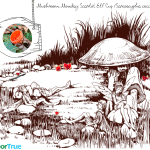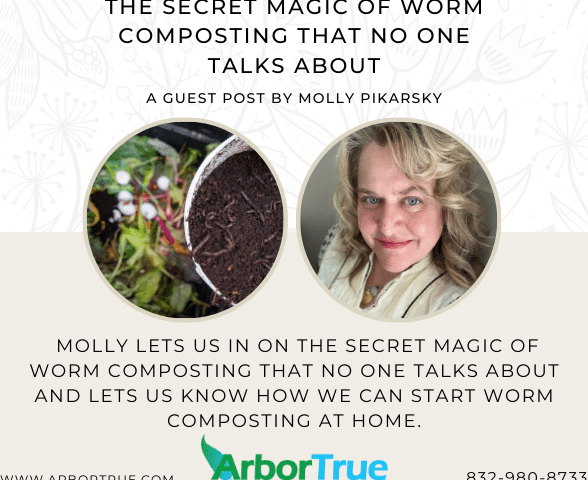
Mushroom Monday: Scarlet Elf Cup (Sarcoscypha coccinea)
October 28, 2024
Mushroom Monday: Common Bonnet (Mycena galericulata)
November 4, 2024

Today we have a special blog post from arborist and landscaper Molly Pikarsky. Today she lets us in on the secret magic of worm composting that no one talks about and lets us know how we can start worm composting at home.
The Secret Magic of Worm Composting That No One Talks About
By Molly Pikarsky, TMCNP, ISA Certified Arborist(R) TX-4988A
Indoor worm composting, also known as vermicomposting, is an innovative and eco-friendly way to recycle kitchen scraps and produce nutrient-rich compost. Perfect for urban dwellers with limited outdoor space, this method harnesses the power of worms to break down organic waste efficiently. But what is the real secret hiding in the worms? It isn’t their poop, it is what is IN the poop. Surprise! It is microbiology.
Within the gut of the worms there is a plethora of beneficial microbiology. Transferring the microbes from the gut of the worms to the soil is the real purpose of using worm castings. The worms break down organic matter and create worm castings, which are rich in beneficial microorganisms. Here are some key benefits related to the microbiology they produce and how it enhances soil health:
-
Diverse Microbial Population
Worm castings contain a diverse array of microorganisms, including bacteria, fungi, protozoa, and nematodes. This microbial diversity is essential for a healthy soil ecosystem, as different microbes play distinct roles in nutrient cycling and soil fertility.
-
Nutrient Availability
The microbes found in worm castings help to break down complex organic compounds into simpler, more accessible forms. This process enhances the availability of essential nutrients like nitrogen, phosphorus, and potassium for plant uptake. The microbes effectively release nutrients in a form that plants can use, promoting healthy growth.
-
Improved Soil Structure
The microbial activity in worm castings contributes to the formation of soil aggregates. These aggregates improve soil structure by creating space for air and water to flow, promoting drainage while retaining moisture. Healthy soil structure also supports root development and enhances plant resilience.
-
Disease Suppression
Beneficial microorganisms present in worm castings can help suppress soil-borne pathogens. Certain bacteria produce metabolites that inhibit the growth of harmful fungi and bacteria, reducing the incidence of plant diseases. This natural disease suppression can lead to healthier plants with increased resistance to pests and illnesses.
-
Enhanced Soil Fertility
The microbial activity in worm castings promotes the process of mineralization, where nutrients locked in organic matter are converted to forms usable by plants. This ongoing process continuously replenishes soil fertility, making it more productive for growing crops and plants.
-
Facilitation of Biodegradation
Microbes in worm castings play a crucial role in decomposing organic matter, including plant residues and other debris in the soil. This biodegradation is vital for nutrient recycling and helps maintain a healthy ecosystem in the soil.
-
Carbon Sequestration
The microbial activity promoted by worm composting can enhance the soil’s ability to sequester carbon, mitigating climate change. Healthy soils with robust microbial communities can store more carbon in the form of organic matter, helping to reduce greenhouse gas concentrations in the atmosphere.
Conclusion
In summary, worm composting not only transforms kitchen scraps into fertile soil amendments but also enriches the soil microbiome. The diverse and active microorganisms produced through vermicomposting significantly improve soil health, enhance nutrient availability, suppress diseases, and contribute to sustainability in gardening and agriculture. Embracing worm composting can lead to richer, more resilient soils, ultimately benefiting both plants and the broader ecosystem.
Directions for Setting Up an Indoor Worm Composting Tub
Materials Needed:
- Worm Tub: A plastic tub (about 10-20 gallons) with a lid and a second tub of the same size to catch liquid. Ensure the first tub has drainage holes or drill them if needed.
- Bedding Material: Shredded newspaper, cardboard, coconut coir, or peat moss.
- Red Wigglers: Purchase red wigglers (Eisenia fetida) from a trusted supplier.
- Food Scraps: Fruit and vegetable peels, coffee grounds, eggshells, and small amounts of paper and cardboard.
- Water Spray Bottle: To maintain moisture levels.
Step-by-Step Setup
- Prepare the tubs:
- Clean the tubs thoroughly to remove any residues. Make sure they are dry before use.
- Make Drainage Holes:
- If your upper tub doesn’t have drainage holes, drill small holes in the bottom to prevent excess moisture buildup.
- Create Bedding:
- Shred newspaper or cardboard into strips and moisten it with water until it is damp but not soaked. Fill the bin with about 4-6 inches of this bedding.
- Add the Worms:
- Open the container of red wigglers and gently spread them on top of the bedding. They will burrow down into their new home.
- Add Food Scraps:
- Begin by adding a small amount of food scraps (about a cup). Bury the scraps in the bedding to prevent odors and fruit flies.
- Cover:
- Place a lid over the tub to keep it dark, as worms prefer a dark environment. The lid helps control moisture and pests.
- Stack the tubs
- Put the top tub into the lower tub to catch any liquids that drip out.
How to Use Your Worm Composting Tub
- Feeding the Worms:
- Continue to add food scraps weekly, burying them under the bedding. Avoid adding meat, dairy, and oily foods, as they can cause odors.
- Maintaining Moisture:
- Check the moisture levels regularly. The bedding should feel like a damp sponge. Use the spray bottle to add water if the bedding appears dry.
- Monitoring Worm Health:
- Check the worms periodically to ensure they are active and healthy. If they are not moving much, check issues like moisture or temperature.
- Harvesting Castings:
- After about 3-6 months, the bedding will transform into dark, crumbly worm castings. To harvest:
- Push all the contents to one side of the bin.
- Add fresh bedding and food scraps to the empty side.
- The worms will migrate to the fresh food, allowing you to scoop out the castings from the other side.
- Using Worm Castings:
- Use the castings as a nutrient-rich fertilizer in potting soil or as a top dressing for indoor and outdoor plants.
If you liked learning about worm composting, check out our other posts on our TrueTreeTalk blog. Follow us on Facebook to keep up with these and other posts.
* * *
ArborTrue is a science-based tree-service company in the greater Houston area. We also serve Austin and other parts of Central Texas. We provide a range of services including tree trimming, tree pruning, tree removal, tree planting, arborist consultations, and more. Call us today at 832-980-8733 (Houston) or at 512-546-3833 (Austin) or reach out to us online to schedule an appointment.



